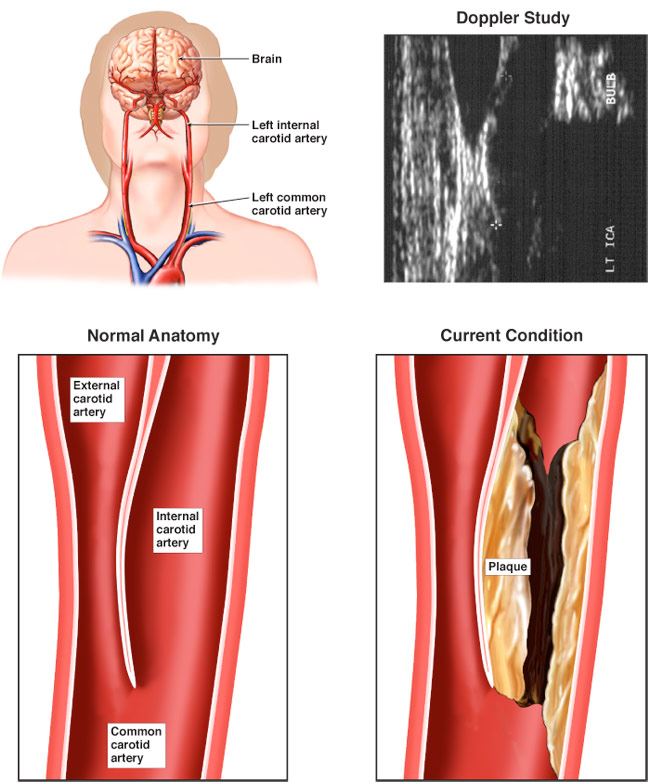Carotid Artery Disease
The carotid arteries are the main blood vessels that carry blood and oxygen to the brain. When these arteries become narrowed, it’s called carotid artery disease or carotid artery stenosis. The narrowing is due to the buildup of plaque (atherosclerosis) inside the wall of the carotid artery. As plaque builds up, the walls of these arteries start thickening. This thickening reduces the amount of blood flow to organs and tissues connected to these arteries.
Carotid artery disease reduces the flow of oxygen to the brain. Carotid artery disease may occur suddenly (acute) or develop gradually (chronic). Either way, the brain needs a constant supply of oxygen to work. If the narrowing of the carotid arteries becomes severe enough or if a piece of plaque breaks off, a stroke can occur. Carotid artery disease is similar to coronary artery disease, in which plaque buildup occurs in the arteries of the heart.

Medical Illustration Copyright © 2019 Nucleus Medical Media, All rights reserved.
Causes of Carotid Artery Disease
The most common cause is build-up of plaque in the carotid arteries due to multiple risk factors including:
Non-Modifiable Risk Factors: These factors are irreversible and cannot be changed. The more of these risk factors you have, the greater your chance of developing carotid artery disease.
- Men younger than age 75 have a greater risk than women in the same age group; women have a greater risk than men older than age 75.
- Family history/genetics
Modifiable Risk Factors: These factors can be modified, treated or controlled through medications or lifestyle changes.
- Diabetes: When your blood glucose, also called blood sugar, is too high.
- High blood pressure
- High cholesterol
- Obesity or having a body mass index “BMI” of 30 or greater.
- Little to no physical activity.
- Long history of cigarette smoking and/or drug abuse.
Symptoms of Carotid Artery Disease
Most people with carotid artery disease experience no symptoms. The first signs of carotid artery disease may be a stroke or transient ischemic attack symptoms. These symptoms include:
- B.E. F.A.S.T.: balance problems, eye blurriness, face drooping, arm weakness, speech difficulty — time to call 911.
- Sudden trouble seeing in one or both eyes.
- Sudden confusion, trouble speaking or understanding speech.
- Difficulty swallowing.
- Sudden loss of balance or coordination.
- Sudden severe headache.
- Sudden numbness or weakness on one side of the face, in one arm or leg, or one side of the body.
Diagnosis of Carotid Artery Disease
Your doctor is likely to start with a thorough medical history and physical examination. The exam generally includes listening for a swooshing sound (heart murmur) over the carotid artery in your neck. If this sound is heard over an artery, it may indicate plaque is building up inside the artery. Carotid artery disease may also be detected during an eye examination if your doctor detects a plaque in the artery that supplies the retina.
You will be asked questions about symptoms and medical history, including questions about family members. After that, you may have one or more of the following diagnostic tests and procedures:
Treatment of Carotid Artery Disease
The goal of treating carotid artery disease is to prevent stroke. Specific treatments depend on the extent of blockage in your carotid arteries. Treatment options include:
Lifestyle Changes
- Avoid smoking.
- Eat a heart-healthy diet.
- Exercise under the directions of your doctor.
- Limit alcohol consumption to 1 drink per day for women and 2 drinks per day for men.
- Make and keep appointments to see your doctor for routine check-ups and follow-up tests.
Medications
- Aspirin will treat pain, inflammation and reduce risk of a stroke.
- Anticoagulants “blood-thinners” will help treat, prevent, and reduce blood clots.
- Beta blockers will help reduce your blood pressure.
- Statins will help reduce the level of cholesterol in the blood.
